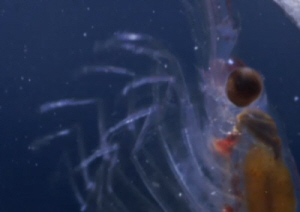Krill & Algae
Crab-Eater Seal, Humpback Whale
South Georgia Scenery
As summer progresses even more of the Southern Ocean is gradually opening up. A summer melt, as it moves south it arrives first at the Antarctic
peninsula, the most northern tip of the continent.
As the ice retreats, a 500 mile long coastline is revealed for the first time in seven months. This new seascape is home to one of the most numerous mammals on the planet; crab-eater seals, over 15 million of them live here amongst the drifting ice floes. They owe their existence here to living organisms so small, you might barely noticed them.

Krill Sieve
The underside of the sea ice is stained by algae. These microscopic plants support the most important Antarctic creatures of all; krill. They
have been grazing on the algal layer throughout the winter. As the ice melts more of algae are released into the water. Both algae and krill flourish
in the summer sun.
Flourishing Krill
The krill collect the algae in the sieve-like basket formed by the interlocking hairs between their front legs. There are 300 million tonnes
of krill in the southern oceans with a greater combined weight than that of any other animal on the planet.
Almost all the animals of the Antarctic depend on krill, including it's giants; humpback whales.

